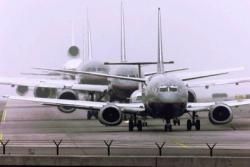But Airlines Did Better In March 2008 Than Month Before
 When it comes to
on-time flights for the nation's airlines -- and lack of same --
the US Department of Transportation would prefer consumers look at
the glass as half-full, not half-empty. But passengers only want to
know who's been drinking out of their glass.
When it comes to
on-time flights for the nation's airlines -- and lack of same --
the US Department of Transportation would prefer consumers look at
the glass as half-full, not half-empty. But passengers only want to
know who's been drinking out of their glass.
On Wednesday, the DOT noted the rate of on-time flights for the
largest US airlines in March 2008 was lower than in the same month
last year... but higher than the rate recorded in February.
According to the Air Travel Consumer Report, the 19 carriers
reporting on-time performance recorded an overall on-time arrival
rate of 71.6 percent in March, below March 2007’s 73.3
percent but better than February 2008’s abysmal 68.6
percent.
Performance figures often improve as temperatures get warmer, as
they usually do from February to March in the US.
In March 2008, carriers canceled 2.6 percent of their scheduled
domestic flights, the same rate recorded in March 2007 but down
from February 2008's 3.6 percent. Reporting carriers said 8.56
percent of their flights were delayed by aviation system delays,
compared to 9.36 percent in February; 8.87 percent by late-arriving
aircraft, compared to 9.74 percent in February; 7.11 percent by
factors within the airline’s control, such as maintenance or
crew problems, the same percentage as in February; 0.93 percent by
extreme weather, compared to 1.19 percent in February; and 0.07
percent for security reasons, compared to 0.05 percent in
February.
 Weather is a factor in
both the extreme-weather category and the aviation-system category.
This includes delays due to the re-routing of flights by
DOT’s Federal Aviation Administration in consultation with
the carriers involved. Weather is also a factor in delays
attributed to late-arriving aircraft, although airlines do not
report specific causes in that category.
Weather is a factor in
both the extreme-weather category and the aviation-system category.
This includes delays due to the re-routing of flights by
DOT’s Federal Aviation Administration in consultation with
the carriers involved. Weather is also a factor in delays
attributed to late-arriving aircraft, although airlines do not
report specific causes in that category.
The year-over-year decline in airline performance continued in
the areas of mishandled baggage and complaints about quality of
service.
Once again, Hawaiian Airlines led on-time performance, with 94.5
percent of its flights arriving within 15 minutes of scheduled
times. US Airways was a distant second, at 79.1 percent. Airlines
with the poorest showings included American Airlines (only 62
percent of flights arriving ontime,) and regional carriers Comair
(66 percent) and American Eagle (66.4 percent... it should
raise eyebrows at AMR that its regional subsidiary outperformed
mainline in this regard -- Ed.)
American's flight 791 from LaGuardia to DFW was the most
frequently delayed, arriving on time a scant 7.69 percent of the
time. Curiously, Southwest Airlines -- often near the top of
consumer rankings, and overall performance -- chalked up two of the
worst performing flights in March 2008: Flight 274 from Las Vegas
to Reno, and flight 50 from Dallas Love Field to Kansas City, both
late 90 percent of the time.
American Eagle "led" in the number of cancelled flights, with
5.9 percent of its March schedule cancelled. American mainline was
a close second, with 5.6 percent of its schedule axed for the
month.
As ANN reported, the airline
cancelled 200 flights on March 26 alone, in order to reinspect its
fleet of MD-82 and MD-83 airliners for issues related to wiring
harnesses. Two weeks later, the airline cancelled over
3,300 flights for the same problem; those numbers will hit
American's figures in April.

By comparison, Frontier Airlines posted the best numbers in
regards to cancelled flights, with 0.5 percent of its flights
cancelled in March. Alaska Airlines and Hawaiian Airlines filled
out the top three; both cancelled less than one percent of their
flights.
 Unfortunate... ANN/SportPlane Resource Guide Adds To Cautionary Advisories
Unfortunate... ANN/SportPlane Resource Guide Adds To Cautionary Advisories ANN FAQ: Turn On Post Notifications
ANN FAQ: Turn On Post Notifications ANN's Daily Aero-Term (04.29.24): Visual Approach Slope Indicator (VASI)
ANN's Daily Aero-Term (04.29.24): Visual Approach Slope Indicator (VASI) ANN's Daily Aero-Term (04.28.24): Airport Marking Aids
ANN's Daily Aero-Term (04.28.24): Airport Marking Aids ANN's Daily Aero-Linx (04.28.24)
ANN's Daily Aero-Linx (04.28.24)





